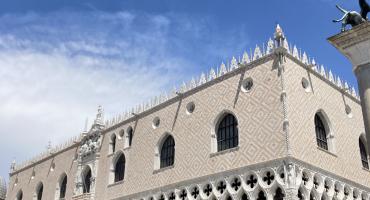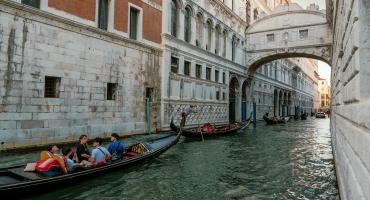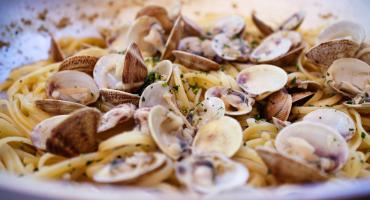Extraordinary example of Venetian civil-Gothic architecture, house of Doges and headquarters of the highest civil magistratures, it is the symbol of the city, the highest representation of the power and glory of the Serenissima Republic.
Inside the palace, it is possible to visit the halls of the Major Council, the Senate, the Electoral college, all decorated with paintings by Tintoretto, Tiziano and Veronese, and also the Doge’s rooms, the famous Council of Ten, the armory and the prisons.
The building, established as castle during the 9th century, acquired its present form only during the 14th and 15th century. Its structure consists of a series of constructive and decorative elements, fine decorations with symbols and allegorical motifs, capitals and sculptures.
Through the Porta della Carta, a Gothic door beside Saint Mark’s Basilica, you enter the beautiful courtyard, with in the center two bronze puteals, dated back 1500. Above the entrance side, the Foscari arch, a Gothic work of 1470; in front of it the Scala dei Giganti, a masterpiece of the Renaissance art by Antonio Rizzo (end of 15th century) with the statues of Mars and Neptune by Jacopo Sansovino (1554), in front of them the new elected Doge swore loyalty to Venetian laws.
From a southeast staircase you can go up to the Gothic loggia, which, through the magnificent Scala D’Oro (1559), leads you to the first piano nobile, whose halls, decorated with paintings by Giovanni Bellini, Tiziano, Carpaccio, belonged to the ducal chambers.
Up on the second piano nobile, a wooden ceiling (16th century), canvas by Jacopo Tintoretto; on the walls paintings by Veronese and Francesco Bassano.
The visit continues through the Sala delle Quattro Porte, where you can admire Il doge Grimani in ginocchio davanti alla Fede, famous work by Tiziano (1556).
Continuing with the Anticollegio, whose walls are decorated with four panels by Tintoretto and one canvas by Paolo Veronese, you can enter the Sala del Collegio: on the walls canvas by Tintoretto and Veronese, on the ceiling panels by Veronese (1577)
You will then enter the Council of Ten and the Council of Ten’s three governors, whose carved and golden ceilings still preserve panels by Paolo Veronese and his school.
Down the passage of the Major Council hall, you will enter the Quarantia Civil Vecchia and sala dell'Armamento (the “arming hall”), where you will find the remains of a magnificent fresco by Guariento (1365-67), ruined by a fire in 1577. In the following loggia, statues of Adam and Eve by Antonio Rizzo of 1464.
From here, you will get at the Major Council room: on the walls paintings and a decoration with 76 portraits of doges by Tintoretto (the one of Marin Faliero, beheaded on 1355 for conspiracy, has been replaced by a black background).
In the center of the ceilings, Apoteosi di Venezia, by Veronese.
Going down the loggia, you can partly see the Old Prisons, called “pozzi”, anguish, moist and dark cells. Crossing the Bridge of Sight, you can visit the unsetting New Prisons, of the second half of the 16th century, and the torture chambers.
Upon booking, it is possible to visit the Secret Itineraries of the Doge’s Palace, an itinerary through the less lavish rooms of the Palace, where bureaucracy worked and justice questioned and tortured the suspected.
Information:
Opening hours:
Everyday
- Summer schedule: from 1st April to 31st October: 9 am - 7 pm
- Winter schedule: from 1st November to 31st March: 9 am - 6 pm
Special evening openings (from 1st May to 30 September)
- every Friday and Saturday / 9 am - 11 pm
Prices:
First Option: "The Museums of St. Mark’s Square"
Ticket – Full price: €30.00 // Reduced price: €15.00
(This ticket is valid for the integrated itinerary that includes: the Doge’s Palace, the Correr Museum, the National Archaeological Museum, and the Monumental Rooms of the Marciana National Library.)
(Online advance purchase discount — if booked at least 30 days in advance via the official website https://muve.vivaticket.it/it/event/musei-p-san-marco-ducale/155153?idt=...): Full price: €25.00 // Reduced price: €13.00
** Holders of "Museums of St. Mark’s Square" tickets without a specific time slot may enter the Doge’s Palace starting from 12:00 PM. **
Second Option: Museum Pass
The "Museum Pass" grants access to all Civic Museums of Venice: the Museums of St. Mark’s Square and many others, including Ca’ Rezzonico, Ca’ Pesaro, Palazzo Mocenigo, and more (visit the website for full details: https://www.visitmuve.it).
-MUSEUM PASS Full price: €40.00
-MUSEUM PASS Reduced price: €22.00
Tickets can be purchased at https://muve.vivaticket.it/it/event/museum-pass/188682
** Online reduced tickets are available only for: Children aged 6 to 14 ; Students aged 15 to 25; Visitors over 65. For all other discounts and for free admission, visitors must go to the ticket office in person and present valid documentation proving eligibility. **
Contacts:
Tel. office: +39 041 2715911
Tel. booking e ticketing: 848082000 (from Italy) / +39 041 42730892 (only from abroad)
E-mail: prenotazionivenezia@coopculture.it
For any other information please check the website: https://palazzoducale.visitmuve.it
Adress: Palazzo Ducale San Marco 1, 30124 Venezia
Principal access: Porta del Frumento, Piazzetta San Marco
How to get there: water bus, stop "S. Marco"
Copyright Notice: these images have been sourced online. If you are the copyright holder and wish for it to be removed, please contact us.



